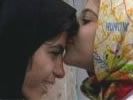Eye For Film >> Movies >> The Glass House (2009) Film Review
Life for women in modern Iran has been fairly thoroughly documented in recent years, particularly by British film-maker Kim Longinotto. In 1998, along with co-director Ziba-Mir Hosseini, she took a look at Divorce Iranian Style, highlighting prejudicial laws which favour fathers as regards custody of children after a marriage split, and in 2001, she examined the plight of Iran's vulnerable teenagers in Runaway.
All of which goes to make director Hamid Rahmanian's documentary feel rather like too little, too late. He, too, is looking at women on the margins, focussing on a day centre which aims to help girls with addictions, or who have fled problems at home, to build up skills and self-esteem. Twenty-year-old Sussan has been beaten by her addict brother, teenager Nazila is finding an escape from her situation through rap music (illegal for women in Iran), while Mitra embraces freedom of expression through her writing. Most affecting, though, is probably 14-year-old Samira, who is battling a drug addiction, having been force-fed them as a youngster.

As always with this type of documentary, there is no doubt that the women's stories are heartbreaking and their voices hold strength, but they are not helped to express their views by Rahmanian, who persists in thrusting the camera in their faces at every opportunity. The camera work is, at best, rough and ready, frequently swooping about in a distracting fashion, while the use of so much close-up footage makes the whole documentary feel far too intrusive.
The girls, like those in Longinotto's documentary and Jafar Panahi's Offside, have spirit to spare, despite their compromised and disenfranchised circumstances, and they operate a tough love system with one another that is touching.
But questions about the day centre itself go unanswered. Its founder Marjaneh Halati, an Iranian-born psychologist now living most of the time in London, established it in 2004 and has clearly become a mother figure to many of the girls in its care, yet virtually no background on her is given. While not for a moment suggesting that she opened the centre for anything less than altruistic reasons, it would be nice if Rahmanian had taken the time to consider her role and motivations a little more fully.
If you have never seen another film concerning the issues of women's rights in Iran, this is worth a look, however, it is not as powerful a document as it could have been.
Reviewed on: 27 Mar 2009

















